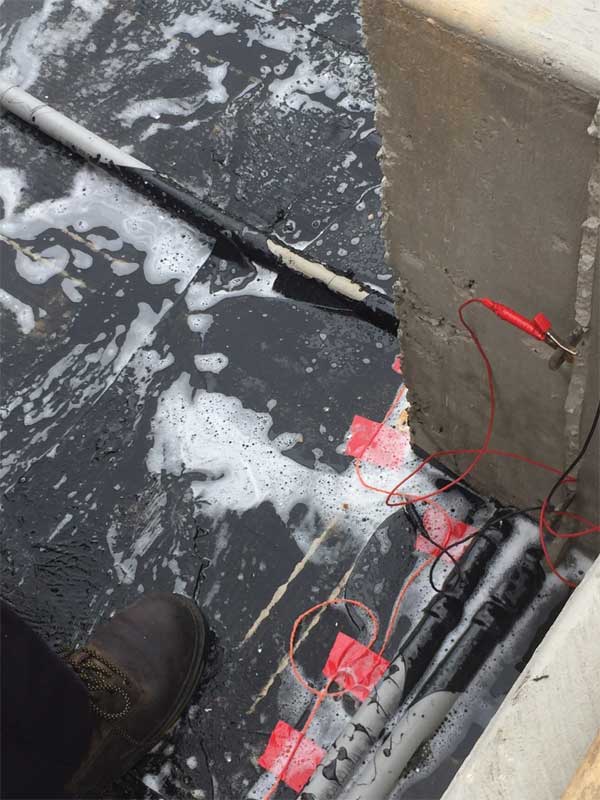
Photo courtesy Luna and Associates
A similar system to this proprietary methodology uses a small scanning platform of approximately 457 x 609 mm (18 x 24 in.), which incorporates a perimeter wire loop of chains that hangs from the platform, making contact with water on the roof surface, as well as a separate line of chains located in the center of the platform. Both series of chains are connected to a low-voltage power source. The platform is moved along the surface of the roof membrane to detect breaches similar to the EFVM system.
Low-voltage electrical conductance testing cannot be used for roofs with a vapor retarder, because the vapor retarder will hide roof leaks by blocking the electrical field, just as the roofing does. Additionally, this testing method will not work with an electrically conductive roof material such as black ethylene propylene diene monomer (EPDM) because it contains carbon black. Similarly, it is unsuitable for roofs with aluminized protective coatings, which are commonly employed over modified bituminous (mod-bit) membranes.
There are two advantages of low-voltage electrical conductance testing over traditional flood-testing and other types of electronic leak testing:
- It can provide leak detection throughout the life of the roofing, precisely locating leaks with pinpoint accuracy.
- It can test sloped roofs and vertical walls.
High-voltage spark testing
High-voltage spark testing is similar to low-voltage electrical conductance testing, but uses a 1000- to 30,000-volt direct current (DC), and does not require a wet membrane or wire loop. The system uses an electrically charged metal ‘broom’ connected to the power source, which is grounded to a conductive roof deck. When the metal broom passes over a discontinuity in the dry roof membrane, the electrical circuit is complete, and an audible sound is generated by the testing equipment.
High-voltage spark testing cannot be used for roofs with a vapor retarder, for the same reason described for low-voltage electrical conductance procedures. Likewise, it will not work with an electrically conductive roof material such as black EPDM or membranes using aluminized protective coatings. For ballasted and vegetated roof assemblies, testing must be performed before the overburden is in place. The roof membrane must be completely dry for this testing method to work. Due to the higher voltage used, more false positives have been reported with this testing method than with low-voltage electrical conductance testing.
The advantages of high-voltage spark testing over traditional flood-testing are its capability to provide leak detection throughout the life of the roofing, to precisely locate leaks, and to test sloped roofs and vertical walls.
Conclusion
With such advancements in electronic leak detection, the industry has access to an array of testing options far superior to flood-testing. Each option has its own advantages and disadvantages. Factors to consider when selecting a leak detection testing procedure include:
- the size of the roof;
- cost of testing;
- availability of testing within the geographical region of the building; and
- for existing roofs, the extent of possible leaks as evidenced by interior damage to the building.
Ronald J. Ray, RA, CCS, CCCA, CSI, AIA, is an architectural specification writer with ARCOM with almost 40 years of experience. Previously, he was in private practice as an independent specification consultant for architectural, structural engineering, and civil engineering firms, producing more than 420 project manuals for a wide range of project types. While employed at different architectural firms, Ray was a project manager, project architect, and designer, specializing in the design of churches, schools, and professional sports facilities. During his 32 years of membership in CSI, he has served on the board for two different chapters, chaired committees, and written bylaws for both chapters. Ray can be reached at rray@arcomnet.com.





Well said! Sometimes, despite Google Analytics telling me otherwise, I feel as if I’m talking to myself. It’s great to get comments, it gives me a warm fuzzy feeling without the use of red wine